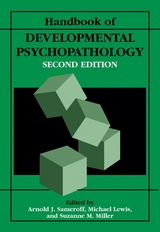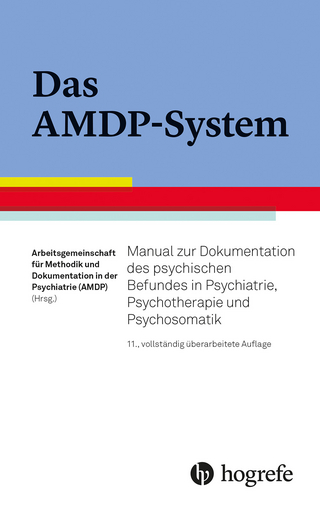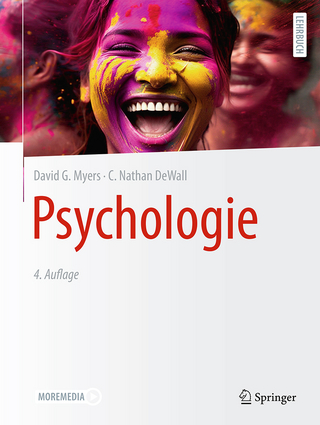
Handbook of Developmental Psychopathology
Kluwer Academic / Plenum Publishers (Verlag)
978-0-306-43190-6 (ISBN)
- Titel erscheint in neuer Auflage
- Artikel merken
This year saw the publication of a new journal, Development and Psychopathology (1989), edited by Cicchetti and Nurcombe. And attend- ees at recent meetings of the Society for Research in Child Development can attest to the growing interest of the membership in the linkage of development and psychopathology as seen and heard via posters, symposia, and guest speakers.
I Issues and Theories of Developmental Psychopathology.- 1 Conceptualization of Developmental Psychopathology.- Why Do We Need Developmental Psychopathology?.- Developmental Psychopathology as a Conceptual Framework.- Relations between Developmental Psychopathology and Other Approaches.- The Relevance of Developmental Periods.- Applications of Developmental Psychopathology.- An Assessment Model for Developmental Psychopathology.- Summary and Conclusions.- References.- 2 Models of Developmental Psychopathology.- Trait or Status Model.- The Environmental Model.- The Interactional Model.- Summary.- References.- 3 Challenges to the Study of Developmental Psychopathology.- Prospective and Retrospective Prediction.- Nature of Maladaptive Behavior.- Diagnostics, Screening, and Evaluation.- Catastrophe and the Notion of Predictability.- Summary.- References.- 4 Culture and Psychopathology.- Early Formulations of Culture and Psychopathology: Benedict and Mead.- Freudian Theory in the "Culture and Personality" School.- Cross-Cultural Perspectives on Mental Illness: Epidemiology and the "Culture-Bound Syndromes".- Individual Differences and the "Goodness of Fit".- Cultural Structuring of Responses to Individual Differences.- Cultural Structuring of Responses to Behavioral Distress in the United States: The "New Morbidity".- Culture and Developmental Psychopathology.- References.- 5 Taxonomy in Developmental Psychopathology: Consider the Source.- The Importance of Sources of Information.- Review of Research Concerned with Different Sources of Information in Assessment.- Use of Multisource Information in the Diagnosis of Child Psychopathology.- Use of Specific Sources of Information.- Conclusions.- References.- II Undercontrolled Disorders.- 6 Attention Deficit Disorders: History, Definition, and Diagnosis.- History.- Description.- Developmental Course.- Current Diagnostic Criteria.- Summary.- References.- 7 The Socialization and Social Development of Hyperactive Children.- Developmental Tasks and Hyperactivity.- Socialization Influences.- Peer Relationships.- Summary and Conclusions.- References.- 8 Genetics and Biochemistry in Attention Deficit Disorder.- Diagnostic Heterogeneity.- Etiological Heterogeneity.- Family Studies.- TwinStudies.- Adoption Studies.- Dysmorphology.- Genetic Latent Structure Analysis.- Biochemical Hypotheses.- References.- 9 Conduct Disorders.- Categorical Approaches: Formal Diagnostic Systems.- Dimensional Approaches.- Relationship between Conduct Disorders and Other Disorders.- Prevalence.- Stability and Course.- Psychological Correlates.- Conclusions.- References.- 10 Behavioral Genetics and Aggressive Behavior in Childhood.- Individual Differences and the Normal Distribution.- Quantitative Genetics.- Behavioral Genetic Research on Disorders Related to Aggressive Behavior.- Behavioral Genetic Research on Aggressive Behavior.- Other Behavioral Genetic Issues concerning Aggressive Behavior.- References.- 11 Learning of Aggression.- Social Learning Theory.- Social Cognition and Aggression.- Family Influences on Aggression.- Peer Influences on Aggression.- Media Influences on Aggression.- Conclusions.- References.- 12 The Stability of Aggressive Behavior-Even unto the Third Generation.- Stability of Aggression over 22 Years.- Intergenerational Transmission of Aggression.- A Cross-National Study.- Implications of Stability of Aggression.- References.- 13 Morality and Conduct Disorders.- Theories of Moral Development.- Relations between Moral Judgment and Delinquency.- Modification of Juvenile Delinquents' Moral Reasoning.- Conclusions.- References.- 14 The Development of Prosocial Behavior versus Nonprosocial Behavior in Children.- Personal Characteristics Associated with Nonprosocial versus Prosocial Responding.- Socialization of Prosocial Behavior.- Summary.- References.- III Overcontrolled Disorders.- 15 Anxiety in Children: Nature and Development.- Diagnosis.- Summary.- Assessment of Childhood Anxiety Disorder.- Epidemiology of Childhood Anxiety Disorders.- Evolution and Outcome of Fear and Anxiety.- Theories of Etiology.- Conclusions.- References.- 16 Separation Anxiety.- Development of Separation Responses.- Mechanisms and Functions of Separation Protest.- Normal Individual Differences.- Traumatic Separation.- Psychopathology.- Treatment of Separation-Related Problems.- References.- 17 The Temperamental Qualities of Inhibition and Lack of Inhibition.- Biological Contributions.- Summary.- References.- 18 The Importance of Peer Relations.- Sociometric Measures.- Predictive Evidence of Peer Acceptance.- Explanations for the Risk Relation.- References.- 19 Test Anxiety in the School Setting.- Conceptualizing Test Anxiety.- School Evaluation and Anxiety.- Conclusion and Directions for Future Research.- References.- 20 Posttraumatic Stress in Children following Natural and Human-Made Trauma.- Precipitating Events.- Symptoms of PTSD.- Natural versus Technological Disasters.- Human-Made Events.- Natural Disaster.- Conclusions.- References.- 21 The Developmental Psychopathology of Child Maltreatment.- Goals of This Chapter.- Historical Perspective.- The Developmental Psychopathology Perspective.- Definitional Issues.- Sequelae of Child Maltreatment: Initial Studies.- The Influence of Current Etiological Models upon the New Wave of Studies on the Developmental Sequelae of Child Maltreatment.- Recent Research Studies on the Developmental Sequelae of Child Maltreatment.- Prevention.- Conclusion.- References.- 22 Childhood Fears and Phobias.- Definition.- Summary of Evidence.- Nature of the Fear Response.- Overcoming Fears.- From Fears to Phobias.- References.- IV Depression.- 23 Depression across the Early Life Span.- Depression: Symptoms, Syndrome, Disorder.- Clinical Picture and Subtypes.- Assessment.- Etiologic Theories.- Links between Depression in Infancy, Preschool, Grade School, and Adolescence.- Directions for Future Research.- References.- 24 Etiologic Perspectives on Depression in Childhood.- Depression and Loss.- Parental Influences.- Children's Factors.- Conclusions.- References.- 25 Psychobiology of Childhood Depression.- Family History Studies of Childhood Depression.- Neuroendocrine Studies.- Polysomnography.- Biological Treatment of Childhood Depression.- References.- 26 Cognitive Components of Depression.- Self-Evaluation.- Personal Causation.- Time Concepts.- Distortion of Present and Past Events.- Concluding Comments.- References.- V Specific and Pervasive Disorders.- 27 Borderline Disorders in Childhood.- History.- Diagnostic Issues.- Etiology.- Follow-Up Studies.- Treatment.- Future Directions.- References.- 28 Taxonomy of Major Disorders in Childhood.- Early Childhood Autism.- Characteristics of Autism.- The Causes of Autism.- LaterOutcome.- The Classification of Autism.- The Differential Diagnosis between Autism and Other Childhood Disorders.- Autism or Childhood Schizophrenia?.- Autism as a Form of Mental Retardation.- Autism and Severe Developmental Language Disorders.- Autism and Asperger's Syndrome.- Distintegrative Disorders.- Concluding Comments.- References.- 29 Autism and Pervasive Developmental Disorders.- Origins and Classification.- Epidemiology.- Clinical Characteristics from Infancy to Adulthood.- Theories of Autism.- Treatment and Education.- References.- 30 The Nature and Types of Mental Illness in the Mentally Retarded.- Diagnostic and Treatment Challenges.- Nature of Mental Illness in the Retarded.- Influences of the Level of Retardation.- Frequency and Types of Mental Illness in the Retarded.- Conclusion.- References.- 31 A Developmental Perspective on Eating Disorders and Eating Problems.- Eating Disorders.- Theories of Etiology.- The Developmental Emergence of Eating Problems.- Cultural Influences.- Proximate Influences.- Eating Disorders and Developmental Psychopathology.- References.- 32 The Elimination Disorders: Enuresis and Encopresis.- Basic Physiological Mechanisms.- Nomenclature and Prevalence.- Clinical Diagnosis.- Etiology.- Treatment.- A Final Word about Treatment.- References.- 33 Physical Disorders.- Tourette Syndrome and Tics in Childhood.- Sleep Disturbances and Disorders of Arousal.- Enuresis.- Encopresis.- Stuttering.- References.- 34 Sexual Development and Sexual Psychopathology: An Object Relations Point of View.- Object Relations Theory.- Sexual Development.- The Causes of Sexual Symptomatology.- Sexual Symptomatology in Childhood.- Sexual Symptomatology in Adolescence.- Sexual Difficulties in Adulthood.- Sexual Dysfunctions and Adult Sexual Symptomatology.- Concerning the Lack of Specificity in Cause and Effect.- Sexual Identity.- Homosexuality and the Paraphilias.- The Paraphilias.- Sexual Maturity.- References.- VI Intervention.- 35 Institutionalization Revisited: Expanding Views on Early and Cumulative Life Experiences.- Early Themes in the Study of Institutionalization.- Controlled Environments and the Search for Causal Relationships.- Individual Differences in Response to Environments.- Modern Forms of Institutionalization: Distinguishing Features.- Toward a Developmental Taxonomy of Care-Providing Environments.- Conclusion.- References.- 36 Perspectives and Interventions: Psychoanalysis and Psychoanalytic Psychotherapy, Family Therapy, and Community Psychology.- Psychoanalysis and Psychoanalytic Psychotherapy.- Family Therapy.- Community Psychology.- Summary.- References.- 37 Cognitive-Behavioral Approaches to Child Psychopathology: Present Status and Future Directions.- A Cognitive-Behavioral Perspective.- The Transition to a Cognitive-Behavioral Model.- Critical Issues in the Cognitive-Behavioral Model.- A Developmental Perspective for Cognitive Behavior Therapy.- Elaborating the Developmental Perspective.- References.- Author Index.
| Zusatzinfo | biography |
|---|---|
| Verlagsort | Dordrecht |
| Sprache | englisch |
| Gewicht | 1370 g |
| Themenwelt | Geisteswissenschaften ► Psychologie ► Klinische Psychologie |
| ISBN-10 | 0-306-43190-4 / 0306431904 |
| ISBN-13 | 978-0-306-43190-6 / 9780306431906 |
| Zustand | Neuware |
| Haben Sie eine Frage zum Produkt? |
aus dem Bereich



